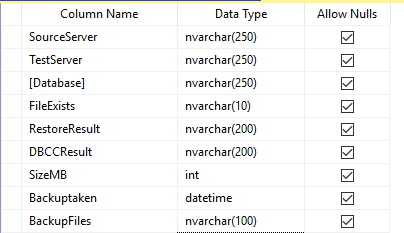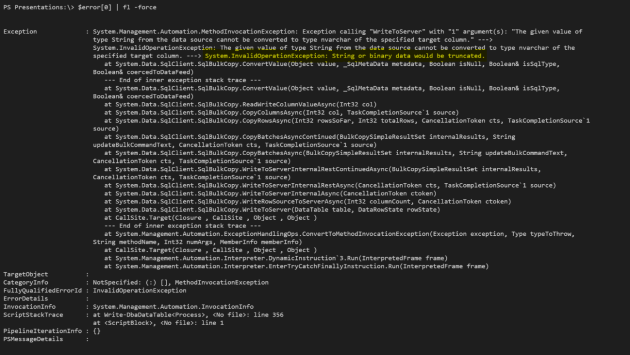Whilst I was writing my Test-DbaLastBackup Posts I ran into a common error I get when importing datatables into a database
I was using this table

and when I tried to add the results of the Test-DbaLastBackup I got this

Exception calling “WriteToServer” with “1” argument(s): “The given value of type String from the data source cannot be converted to type nvarchar of the
specified target column.”
At line:356 char:4
+ $bulkCopy.WriteToServer($InputObject)
+ ~~~~~~~~~~~~~~~~~~~~~~~~~~~~~~~~~~~~~
+ CategoryInfo : NotSpecified: (:) [], MethodInvocationException
+ FullyQualifiedErrorId : InvalidOperationException
Hmm, it says that it can’t convert a string to a nvarchar, that doesn’t sound right.To find out what was happening I used a little bit of code that I use every single day
$Error[0] | Fl -force
All errors from your current session are stored in the $error array so [0] accesses the most recent one and fl is an alias for Format-List and the force switch expands the object. This is what I saw

System.Management.Automation.MethodInvocationException: Exception calling “WriteToServer” with “1” argument(s): “The given value of
type String from the data source cannot be converted to type nvarchar of the specified target column.” —>
System.InvalidOperationException: The given value of type String from the data source cannot be converted to type nvarchar of the
specified target column. —> System.InvalidOperationException: String or binary data would be truncated.
String or binary data would be truncated. OK that makes sense, one of my columns has larger data than the destination column but which one? Lets take a look at some of the data
SourceServer : SQL2016N3
TestServer : SQL2016N1
Database : RidetheLightning
FileExists : Skipped
RestoreResult : Restore not located on shared location
DbccResult : Skipped
SizeMB : 4.08
BackupTaken : 3/19/2017 12:00:03 AM
BackupFiles : C:\MSSQL\Backup\SQL2016N3\RidetheLightning\FULL\SQL2016N3_RidetheLightning_FULL_20170319_000003.bak
SourceServer : SQL2016N3
TestServer : SQL2016N1
Database : TheCallofKtulu
FileExists : Skipped
RestoreResult : Restore not located on shared location
DbccResult : Skipped
SizeMB : 4.08
BackupTaken : 3/19/2017 12:00:04 AM
BackupFiles : C:\MSSQL\Backup\SQL2016N3\TheCallofKtulu\FULL\SQL2016N3_TheCallofKtulu_FULL_20170319_000004.bak
SourceServer : SQL2016N3
TestServer : SQL2016N1
Database : TrappedUnderIce
FileExists : Skipped
RestoreResult : Restore not located on shared location
DbccResult : Skipped
SizeMB : 4.08
BackupTaken : 3/19/2017 12:00:04 AM
BackupFiles : C:\MSSQL\Backup\SQL2016N3\TrappedUnderIce\FULL\SQL2016N3_TrappedUnderIce_FULL_20170319_000004.bak
Hmm, its not going to be easy to work out which bit of data is too big here.
All I need to know is the maximum length of the columns in the datatable though so I have a little snippet that will do that for me
$columns = ($datatable | Get-Member -MemberType Property).Name
foreach($column in $Columns) {
$max = 0
foreach ($a in $datatable){
if($max -lt $a.$column.length){
$max = $a.$column.length
}
}
Write-Output "$column max length is $max"
}and the output looks like this

So we can quickly see that the backupfiles property is too big and change the table accordingly and no more error.

I keep this little snippet in my snippets list for PowerShell ISE which you can find here
## A list of snippets
$snips = Get-IseSnippet
## Add a snippet
if(!$snips.Where{$_.Name -like 'Max Length of Datatable*'})
{
$snippet = @{
Title = 'Max Length of Datatable'
Description = 'Takes a datatable object and iterates through it to get the max length of the string columns - useful for data loads'
Text = @"
`$columns = (`$datatable | Get-Member -MemberType Property).Name
foreach(`$column in `$Columns)
{
`$max = 0
foreach (`$a in `$datatable)
{
if(`$max -lt `$a.`$column.length)
{
`$max = `$a.`$column.length
}
}
Write-Output "`$column max length is `$max"
}
"@
}
New-IseSnippet @snippet
}
Then you can add this bit of json inside the curly braces
"Max Length of Datatable": {
"prefix": "Max Length of Datatable",
"body": [
"$$columns = ($$datatable | Get-Member -MemberType Property).Name",
"foreach($$column in $$Columns) {",
" $$max = 0",
" foreach ($$a in $$datatable){",
" if($$max -lt $$a.$$column.length){",
" $$max = $$a.$$column.length",
" }",
" }",
" Write-Output \"$$column max length is $$max\"",
"}"
],
"description": "Takes a datatable object and iterates through it to get the max length of the string columns - useful for data loads"
}, and you have your snippet ready for use

Happy Automating


